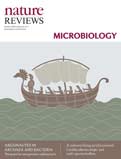|
Advertisement | |||||||||||||||||||||||||||||||||||||
| |||||||||||||||||||||||||||||||||||||
| TABLE OF CONTENTS | |||||||||||||||||||||||||||||||||||||
| January 2018 Volume 16 Number 1 | |||||||||||||||||||||||||||||||||||||
| In this issue
| | |||||||||||||||||||||||||||||||||||
| |||||||||||||||||||||||||||||||||||||
 | |||||||||||||||||||||||||||||||||||||
| |||||||||||||||||||||||||||||||||||||
| NEWS AND ANALYSIS | Top | ||||||||||||||||||||||||||||||||||||
| GENOME WATCH The great escape Eva Heinz p4 | doi:10.1038/nrmicro.2017.156 This month's Genome Watch highlights how genomics has improved our understanding of how vaccines impact pathogen populations and their genomes. | |||||||||||||||||||||||||||||||||||||
| PROGRESS | Top | ||||||||||||||||||||||||||||||||||||
| Prokaryotic Argonaute proteins: novel genome-editing tools? Jorrit W. Hegge, Daan C. Swarts & John van der Oost p5 | doi:10.1038/nrmicro.2017.73 Prokaryotic Argonaute proteins, homologues of eukaryotic Argonaute proteins involved in RNA interference, have recently been demonstrated to mediate host defence in archaea and bacteria. In this Progress article, van der Oost and colleagues explore the structures and biological functions of the prokaryotic Argonaute proteins, and discuss their potential applications in genome editing. Abstract | Full Text | PDF | |||||||||||||||||||||||||||||||||||||
| Anti-CRISPR: discovery, mechanism and function April Pawluk, Alan R. Davidson & Karen L. Maxwell p12 | doi:10.1038/nrmicro.2017.120 CRISPR-Cas adaptive immune systems are widespread in prokaryotes. In this Progress article, Maxwell and colleagues highlight how phages and other mobile genetic elements inactivate CRISPR-Cas systems using anti-CRISPR proteins and outline evolutionary and biotechnological implications of anti-CRISPR protein activity. Abstract | Full Text | PDF | |||||||||||||||||||||||||||||||||||||
| REVIEWS | Top | ||||||||||||||||||||||||||||||||||||
Development and regulation of single- and multi-species Candida albicans biofilms Matthew B. Lohse, Megha Gulati, Alexander D. Johnson & Clarissa J. Nobile p19 | doi:10.1038/nrmicro.2017.107 The ability of Candida albicans to form biofilms is a major cause of disseminated bloodstream infections. Here, Nobile and colleagues review our current understanding of the processes involved in the formation of C. albicans biofilms, the core transcriptional network that regulates biofilm development, and polymicrobial biofilms that are formed by C. albicans and certain bacterial species. Abstract | Full Text | PDF | Supplementary information | |||||||||||||||||||||||||||||||||||||
| Listeria monocytogenes: towards a complete picture of its physiology and pathogenesis Lilliana Radoshevich & Pascale Cossart p32 | doi:10.1038/nrmicro.2017.126 Listeria monocytogenes is a food-borne pathogen responsible for human listeriosis. In this Review, Radoshevich and Cossart discuss the most recent advances in L. monocytogenes physiology, biology and pathogenesis. Abstract | Full Text | PDF | |||||||||||||||||||||||||||||||||||||
| The evolution of seasonal influenza viruses Velislava N. Petrova & Colin A. Russell p47 | doi:10.1038/nrmicro.2017.118 Seasonal influenza viruses continue to cause epidemics each year. In this Review, Petrova and Russell discuss recent advances in understanding the molecular determinants of influenza virus immune escape, sources of evolutionary selection pressure, population dynamics of influenza viruses and prospects for better influenza virus control. Abstract | Full Text | PDF | |||||||||||||||||||||||||||||||||||||
| Erratum: The evolution of seasonal influenza viruses Velislava N. Petrova & Colin A. Russell p60 | doi:10.1038/nrmicro.2017.146 Full Text | PDF | |||||||||||||||||||||||||||||||||||||
| |||||||||||||||||||||||||||||||||||||
| You have been sent this Table of Contents Alert because you have opted in to receive it. You can change or discontinue your e-mail alerts at any time, by modifying your preferences on your nature.com account at: www.nature.com/myaccount For further technical assistance, please contact our registration department For print subscription enquiries, please contact our subscription department For other enquiries, please contact our feedback department Springer Nature | One New York Plaza, Suite 4500 | New York | NY 10004-1562 | USA Springer Nature's worldwide offices: Macmillan Publishers Limited is a company incorporated in England and Wales under company number 785998 and whose registered office is located at The Campus, 4 Crinan Street, London, N1 9XW. © 2018 Macmillan Publishers Limited, part of Springer Nature. All Rights Reserved. |
 |









No comments:
Post a Comment